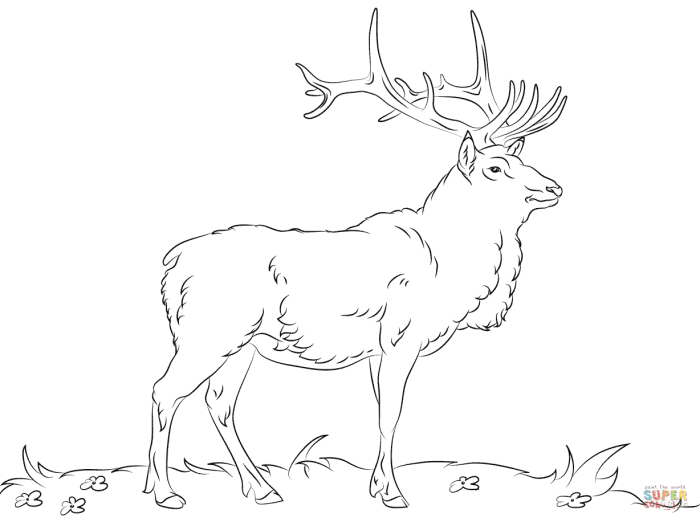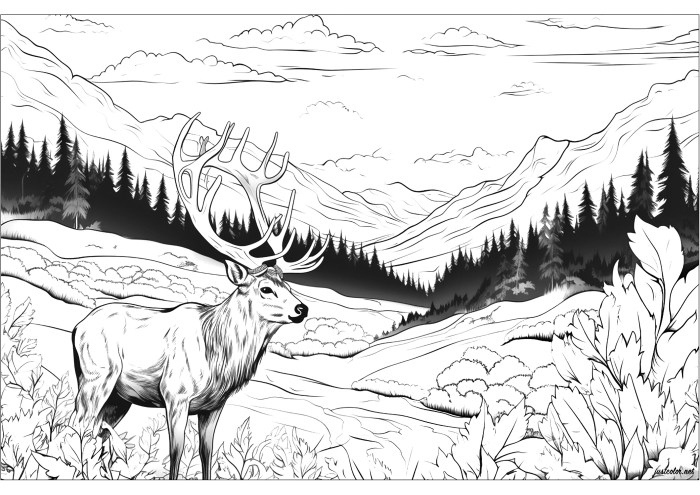Elk Habitat and Environment Depiction

Animal coloring pages elk – Creating accurate and engaging coloring page backgrounds requires careful consideration of elk habitats. The environments depicted should reflect the natural landscapes where these majestic animals thrive, enhancing the overall educational and artistic value of the coloring pages. By accurately representing their natural surroundings, children can learn about the ecosystems elk inhabit and the importance of conservation.Elk habitats vary considerably across their range, encompassing diverse landscapes.
This section will explore three distinct forest scenes and a mountainous habitat, providing detailed descriptions to guide the creation of visually appealing and informative coloring page backgrounds. We will also list key plant species frequently found in these environments.
Forest Scene Variations for Elk Coloring Pages
Three distinct forest scenes can provide varied backgrounds for elk coloring pages. The first depicts a dense coniferous forest, rich with evergreen trees like Douglas fir and Ponderosa pine. The undergrowth would be relatively sparse, with patches of shade and sunlight filtering through the thick canopy. The color palette should feature deep greens, browns, and muted yellows.
The second scene shows a mixed deciduous and coniferous forest. This scene includes a mix of broadleaf trees like aspen and oak, alongside evergreens. The undergrowth would be more varied, with shrubs, ferns, and wildflowers adding pops of color. The color palette here would be broader, including vibrant greens, yellows, oranges, and reds depending on the season. The third depicts an open woodland with scattered trees, primarily aspen and birch, creating a lighter, more open feel.
The undergrowth in this scene is more abundant, featuring grasses, wildflowers, and berry bushes. The color palette would be lighter, with greens, yellows, and whites dominating.
Mountainous Elk Habitat Depiction for Coloring Pages
A mountainous elk habitat coloring page background should include several key visual elements. Rugged, rocky terrain is essential, with varying elevations and slopes. Coniferous trees, such as pine and fir, should cling to the mountain slopes, thinning out at higher altitudes. The use of varying shades of brown, gray, and green to represent the rocky outcrops and sparse vegetation is crucial.
Patches of snow, especially at higher elevations, can add realism, depending on the season depicted. The inclusion of a meandering stream or river cutting through the mountains would enhance the scene’s naturalism and provide a water source for the elk. The overall effect should convey the challenging yet beautiful environment elk inhabit in mountainous regions.
Finding delightful animal coloring pages featuring elk can be a fun activity for all ages. If you’re looking for a broader range of wildlife, you might enjoy the diverse collection in the animal coloring book big sur , which offers a stunning array of Californian creatures. Returning to elk specifically, remember to look for detailed illustrations that capture their majestic antlers and powerful build.
Plants Commonly Found in Elk Habitats
Accurate depiction of flora adds authenticity to elk coloring pages. The following five plants are commonly found in elk habitats and can be included in the backgrounds:
- Aspen (Populus tremuloides): Characterized by its smooth, silvery bark and rounded leaves that tremble in the slightest breeze. Depict these trees with a light, silvery-grey bark and heart-shaped leaves.
- Douglas Fir (Pseudotsuga menziesii): A tall evergreen with soft needles and distinctive cone-like structures. Show these as tall, dark green trees with slightly downward-pointing branches.
- Ponderosa Pine (Pinus ponderosa): A large pine tree with long, needles and reddish-brown bark. Depict the thick, reddish-brown bark and long, needle-like leaves.
- Kinnikinnick (Arctostaphylos uva-ursi): A low-growing evergreen shrub with small, leathery leaves and red berries. Show this as a low-lying, dark green plant with small, round leaves and occasional red berries.
- Western White Pine (Pinus monticola): A tall evergreen with long, soft needles and a bluish-green hue. Depict these as tall trees with long, soft, bluish-green needles.
Color Palette Suggestions for Elk Coloring Pages

Choosing the right color palette is crucial for bringing elk coloring pages to life. The colors selected should accurately reflect the animal’s natural appearance while also allowing for creative interpretation and artistic expression. The palettes below offer a range of options, considering the variations in elk coloring across different seasons and age groups.
Elk Color Palettes for Various Seasons
The following table presents five distinct color palettes, each designed to capture the essence of an elk in a specific season. The palettes incorporate a variety of browns, grays, and other subtle tones to create realistic and visually appealing depictions.
| Palette Name | Dominant Colors | Secondary Colors | Seasonal Applicability |
|---|---|---|---|
| Summer Elk | Rich Brown (#A0522D), Medium Brown (#8B4513) | Light Brown (#DEB887), Dark Brown (#654321), Touches of Green (#808000) for vegetation | Summer |
| Autumn Elk | Russet Brown (#80461B), Burnt Sienna (#E97451) | Dark Brown (#3C200C), Muted Orange (#FF8C00), Gold (#FFD700) | Autumn |
| Winter Elk | Gray-Brown (#A9A9A9), Light Gray (#D3D3D3) | Dark Gray (#808080), White (#FFFFFF) for accents of snow, Black (#000000) for eyes and hooves | Winter |
| Spring Elk | Light Brown (#F5DEB3), Tawny (#D2B48C) | Medium Brown (#8B4513), Green (#3CB371) for new vegetation | Spring |
| Young Elk | Light Brown (#F0D8B6), Sandy Brown (#F4A460) | Dark Brown (#654321), Muted Orange (#FFB347) | All Seasons (for calves/young elk) |
Detailed Explanation of Color Choices
The color choices for each palette are based on observations of elk in their natural habitats. For example, the “Summer Elk” palette utilizes rich browns to reflect the thicker, darker coat typical during warmer months. The inclusion of touches of green subtly hints at the lush summer environment. The “Winter Elk” palette incorporates grays and lighter browns to represent the elk’s winter coat, which often appears lighter and duller due to weather conditions.
The “Autumn Elk” palette incorporates warmer tones like russet and burnt sienna to reflect the fall foliage and the subtle changes in the elk’s coat. The “Spring Elk” palette uses lighter browns to reflect the renewal of the environment and the elk’s lighter coat after shedding. The “Young Elk” palette showcases the lighter and often more reddish-brown fur of young elk.
The secondary colors in each palette provide depth and realism, highlighting details such as shadows, highlights, and environmental context.
Elk Fur Brown Shade Chart, Animal coloring pages elk
This chart illustrates various shades of brown suitable for depicting elk fur, ranging from light to dark. These shades can be mixed and blended to create a natural and realistic appearance.
| Color Name/Hex Code | Description |
|---|---|
| Light Brown (#F5F5DC) | Very light, almost beige brown; suitable for highlights and young elk. |
| Medium Brown (#A0522D) | A standard, mid-toned brown; ideal for the majority of the elk’s coat. |
| Dark Brown (#8B4513) | A deep, rich brown; used for shadows and darker areas of the coat. |
| Very Dark Brown (#3C200C) | A very dark brown, almost black; suitable for the deepest shadows. |
Creating Engaging Elk Coloring Page Designs: Animal Coloring Pages Elk

Designing elk coloring pages requires consideration of age appropriateness and visual appeal. Different age groups have varying attention spans and fine motor skill development, influencing the complexity of designs suitable for them. Line weight and shading techniques play a crucial role in creating visually engaging and stimulating pages.To ensure the coloring pages are appealing and age-appropriate, we’ll consider three distinct designs catering to different age groups.
Each design incorporates elements of the elk’s natural habitat to enhance the overall experience.
Elk Coloring Page Designs by Age Group
The following designs offer a range of complexity, suitable for children of different ages and skill levels. Simpler designs cater to younger children, while more intricate options challenge older children and provide opportunities for creative expression.
- Design 1: Simple Elk for Younger Children (Ages 3-5): This design features a large, simplified elk silhouette. The elk is depicted standing in a meadow with a few simple, large grass blades. The lines are thick and bold, making it easy for young children to color within the lines. Minimal details are included, focusing on basic shapes and forms. No shading is required, allowing for a focus on color exploration.
The overall visual effect is bright and cheerful, encouraging color experimentation without frustration.
- Design 2: Elk in a Forest Clearing for Intermediate Children (Ages 6-9): This design depicts an elk standing in a forest clearing. The elk is more detailed than in Design 1, including more refined features such as ears, antlers, and a more defined body shape. The forest clearing includes several trees, some bushes, and perhaps a small stream. Line weight varies slightly, with thicker lines outlining the main elements and thinner lines for details.
Simple shading can be introduced using light cross-hatching or stippling to add depth to the elk’s fur and the background elements. This design encourages children to develop their fine motor skills and explore more complex color combinations.
- Design 3: Elk Family in a Mountainous Landscape for Older Children (Ages 10+): This design shows a family of elk – a bull, a cow, and a calf – in a detailed mountainous landscape. The elk are realistically rendered with intricate details in their fur, antlers, and body structure. The background includes a complex mountainous terrain with trees, rocks, and possibly a river or lake. The line weight varies significantly, using thin lines for details such as fur texture and thick lines for Artikels and bolder elements.
Shading techniques such as cross-hatching, stippling, and blending are employed to create depth, texture, and a realistic three-dimensional effect. This design challenges older children to explore more advanced coloring techniques and develop their artistic skills.
Line Weight and Shading Techniques
Line weight and shading techniques are essential for creating visually appealing and engaging coloring pages. Varying line weight adds visual interest and helps to guide the coloring process. Thicker lines define the main Artikels and shapes, while thinner lines add detail and texture. Shading techniques, such as cross-hatching, stippling, and blending, can be used to create depth, texture, and a three-dimensional effect.
These techniques are introduced gradually, based on the age appropriateness of the design, ensuring a progressively challenging and rewarding coloring experience. For example, Design 1 utilizes only bold lines, while Design 3 incorporates a variety of line weights and advanced shading techniques. This progressive approach makes the coloring pages enjoyable and suitable for a wide range of ages and skill levels.
FAQ Compilation
What kind of paper is best for coloring elk coloring pages?
Heavier weight paper, such as cardstock or watercolor paper, is recommended to prevent bleed-through, especially when using markers or watercolors.
Are there coloring pages suitable for very young children?
Yes, simpler designs with bolder Artikels and fewer details are included, specifically designed for younger children’s coloring abilities.
Can I use these coloring pages for educational purposes?
Absolutely! These pages can be a valuable tool for teaching children about elk anatomy, habitats, and the importance of wildlife conservation.
Where can I find more information about elk?
Numerous online resources and wildlife conservation organizations provide detailed information about elk behavior, habitats, and conservation efforts.












